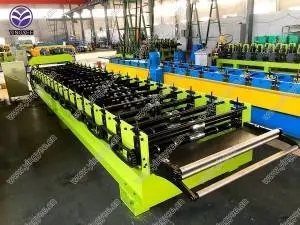
Stud and Track Frame Forming Machine Revolutionizing Construction and Manufacturing
In the ever-evolving landscape of construction and manufacturing, the stud and track frame forming machine stands out as a groundbreaking innovation. This specialized equipment is designed to automate the production of metal framing components, primarily used in the construction of residential and commercial buildings. With the increasing demand for efficient, cost-effective construction practices, the stud and track frame forming machine has gained significant traction among builders, manufacturers, and contractors.
Understanding the Technology
At its core, the stud and track frame forming machine is engineered to produce metal studs and tracks, which serve as the structural framework for walls and ceilings. The machine operates by taking raw metal sheets, typically made of galvanized steel, and transforming them into precise framing components through a combination of cutting, bending, and punching processes. This automation not only speeds up the production process but also ensures consistent quality and accuracy, which is crucial in construction.
The machine usually incorporates advanced technology such as computer numerical control (CNC) systems, allowing for real-time adjustments and precise specifications. Operators can input designs directly into the machine, which then executes the production according to predefined measurements. This minimizes human error and enhances overall efficiency.
Benefits of Using Stud and Track Frame Forming Machines
1. Increased Efficiency One of the most significant advantages of using a stud and track frame forming machine is the drastic reduction in production time. Traditional methods of framing required significant manual labor and time, but with this technology, the same outputs can be achieved in a fraction of the time.

2. Cost-Effectiveness As labor costs continue to rise, investing in a stud and track frame forming machine becomes economically viable for many businesses. The initial investment is often offset by the savings gained from reduced labor costs and faster project completion times.
3. Quality Control The precision offered by these machines results in higher quality products. With automated systems, manufacturers can achieve uniformity in size and shape, which is essential for structural integrity in construction.
4. Versatility Modern machines are designed to handle a variety of metal thicknesses and sizes, making them suitable for different construction applications. This versatility allows businesses to expand their service offerings and cater to a broader clientele.
5. Sustainability With an increasing focus on sustainable building practices, the stud and track frame forming machine supports the use of recycled materials and reduces waste. The preciseness of the machine contributes to efficient material usage, aligning with environmental standards and reducing the carbon footprint of construction projects.
Future Outlook
As technology continues to advance, the stud and track frame forming machine is expected to evolve further. Innovations such as enhanced automation, integration with building information modeling (BIM), and improvements in energy efficiency will likely shape the future of this machinery. Additionally, as the construction industry becomes more reliant on digital solutions, the synergy between smart technologies and framing machines will streamline processes, improve productivity, and enhance overall project outcomes.
In conclusion, the stud and track frame forming machine represents a significant shift in the construction and manufacturing sectors. By improving efficiency, reducing costs, and ensuring high-quality production, this technology is poised to redefine the standards for metal framing. As the industry embraces these advancements, businesses that adopt such innovative solutions will undoubtedly gain a competitive edge in an increasingly demanding market.